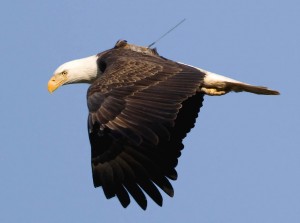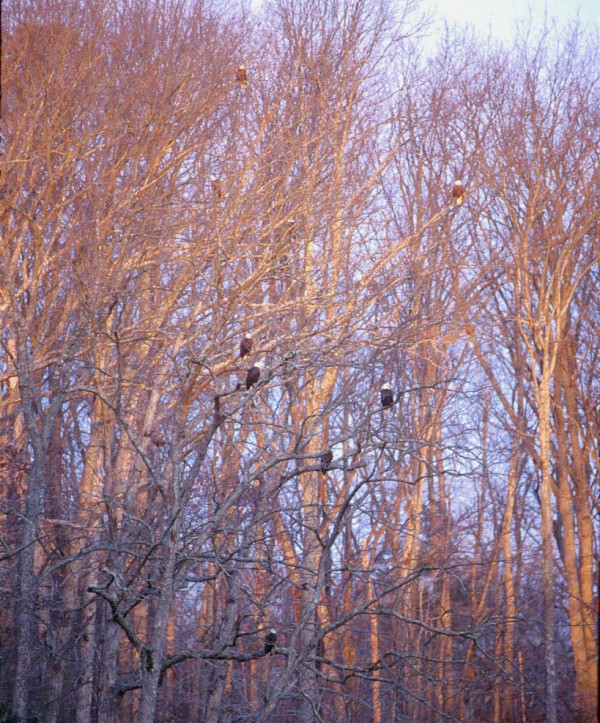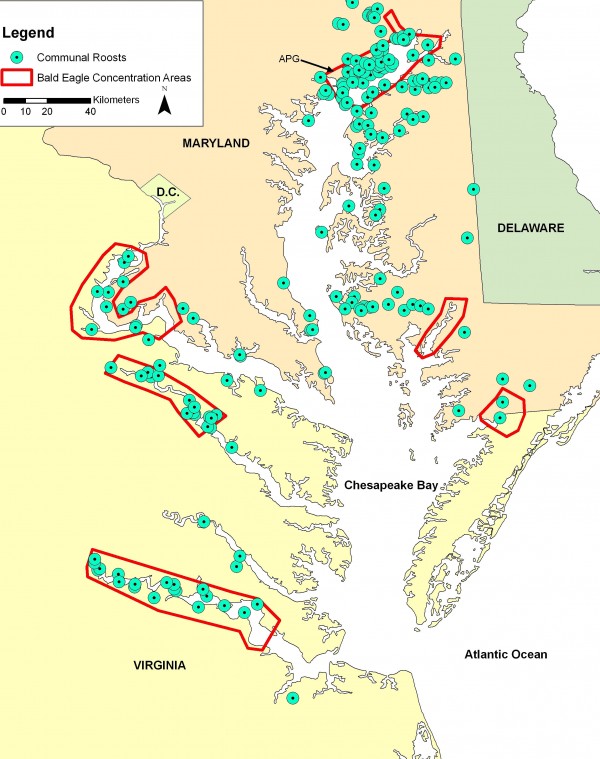Bald eagle communal roosts delineated in the Chesapeake Bay

Landscape dynamics along Virginia’s barrier islands: Assessing habitat stability for disturbance-prone species
October 2, 2008The Avian Heritage of Virginia and Washington D.C.
October 4, 2008
Written by Bryan Watts & Elizabeth Mojica
October 3, 2008

This Center for Conservation Biology satellite-tagged bald eagle was resighted by a local wildlife photographer at Conowingo Dam along the Susquehanna River in MD. Photo by Robert Lin.
Bald eagles congregate in communal roosts, a behavior thought to facilitate information exchange about the location and availability of prey resources. Communal roosts are protected under federal law and managed with a buffer zone to reduce human disturbance. Managing roosts has become increasingly difficult as the eagle population has grown and the population expands into new areas throughout the Bay.
This fall, CCB completed a study to locate eagle roosts in the Chesapeake Bay. GPS locations from 55 bald eagles tagged with satellite transmitters at Aberdeen Proving Ground (see article in Summer e-newsletter, CCB Tracks Eagle Movements throughout the Chesapeake and Beyond), were combined and analyzed using GIS software. Communal roosts were then identified when multiple eagles roosted in the same concentrated area. CCB identified 175 communal eagle roosts throughout the tidal reaches of the Chesapeake Bay. Approximately 75% of these roosts were previously undocumented.
Roosts occurred most frequently in the tidal fresh and oligohaline salinity zones of the Bay tributaries within known eagle concentration areas. Roosts documented in Virginia were on the James River (n=20), Potomac River (n=19), Rappahannock River (n=16) and York River (n=3). Maryland roosts were located on the Blackwater River (n=13), Bush River (n=10), upper Chesapeake Bay (n=32), Chester River (n=13), Elk River (n=4), Gunpowder River (n=4), Pocomoke River (n=4), Sassafras River (n=11), and Susquehanna River (n=22).

Can you spot 6 bald eagles in this cropped photo? Click on the image above to see the full-size photo of 8 bald eagles roosting together. Photo by Bryan Watts.
The National Bald Eagle Management Guidelines (2007) extend the same recommended protections to communal roosts as have been historically provided to active bald eagle nests. However, there has been little effort to locate and delineate communal roosts such that in practice few receive any protection.
Because the Chesapeake Bay is a convergence area for eagle populations along the Atlantic Coast and also hosts a large number of non-breeders, it supports an unusually large number of communal roosts. Although several of these communal roosts occur on conservation lands, the majority of roosts delineated in this study reside on private lands. A greater emphasis should be placed on protecting communal roosts that shelter the approximately 10,000 eagles in the Bay that use them each year. CCB plans to expand future research to investigate roost distribution, seasonal roost dynamics, and roosting ecology.

Communal roosts of bald eagles in the Chesapeake Bay region. Map by the Center for Conservation Biology.



